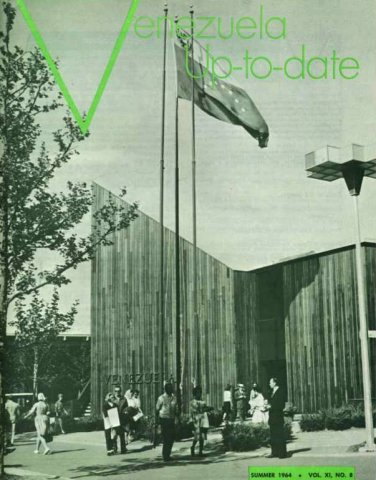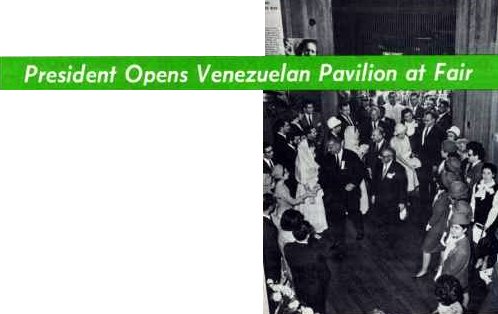Source: Venezuelan
Pavilion Press Release
|

VENEZUELAN PAVILION, NEW YORK WORLD'S FAIR 1964-65
The Venezuelan Pavilion, sponsored by the Ministerio de Fomento
of the Government of Venezuela, was designed by architects Edmundo
Diquez and Oscar Gonzalez, with Stephen Leigh & Associates,
Inc., consultants. It is a sober expression of young Venezuelan
architecture.
Covering an area of 10,000 square feet, the building is constructed
of prefabricated concrete in the form of four hyperparabolic
umbrellas. The walls are of redwood, conceived of as a composition
of planes and volumes separated from each other by open integration
of ceiling and walls provides a dramatic interior effect, whose
changes in perspective will delight the spectator.
The exhibition will demonstrate the imagination of the designer
and the craftsman of Venezuela and will consist of four main
sections. As you enter the Pavilion, you will see the colonial
art and historical background of the country. In this section,
an original altar from one of the first churches built by the
Spaniards in Venezuela will be on display.
In the rear section will be the industrial displays, showing
the potential of Venezuela with samples of manufactured products,
raw materials, technical data on production and marketing, as
well as comprehensive data on the industrial life of the country.
Photographs of plants, factories and other industrial installations
will create the atmosphere for the display of samples of products
pictured. There will be a special exhibit on the oil industry.
Officials from Venezuela's commercial world will be on hand to
discuss opportunities in the country and to answer questions
from American businessmen.
Along the mezzanine of the building, there will be an exhibit
of Venezuelan art, including contemporary and ancient samples
of the cultural life of the country. As you walk out of the pavilion,
you will see the last and most fascinating part of the exhibit
- Venezuela in the future. next to the exit will be a counter
where souvenirs and typical handicrafts of Venezuela will be
on sale.
Among the highlights of the Pavilion will be entertainment
by guitarists, dancers, and other Venezuelan performers. Guitarist
Alirio Diaz, pianist Judith Jaimes and contemporary dance groups
are scheduled for this season. Venezuela will spare no effort
in assuring that each visit to its Pavilion will be a memorable
experience.
|
The Venezuelan pavilion at the
New York World's Fair, designed by two young architects of Caracas,
is a modernistic structure of California redwood with 6,500 square
feet of space. Visitors will find samples of Venezuelan industry,
as well as pictures, charts and displays that give an idea of
the country's development today. President Johnson dedicated the
pavilion in person last May 9.
 |

|
|
President Johnson
shakes hands with the typically attired hostesses at the Venezuelan
Pavilion. At his side is ex-President Betancourt. Following are
Ambassador Tejera-Paris, Mrs. Johnson and Mrs. Tejera-Paris.
|
Source: Venezuela
Up-to-Date Summer 1964, Vol. XI, No. 8
|
The Venezuelan pavilion at the New York World's Fair was open
to the public May 9. President Johnson paid honor to the nation
by dedicating the pavilion in person. After cutting a symbolic
ribbon at the entrance, he and Mr.s Johnson, accompanied by former
President Betancourt, Venezuelan Ambassador and Mrs. Tejera-Paris
and other Venezuelan officials who came especially for the occasion,
viewed the exhibits, shook hands with the hostesses in their
picturesque costumes, and sauntered to admire the works of arts
brought from Venezuela.
Greeting the President, Ambassador Tejera-Paris said: "Your
coming to this pavilion is a great honor you bestow on the people
and Government of Venezuela. You will find this exhibition to
be, not so much a show of industry, in this country of inventors,
as it is the presence of a small but proud country that has achieved
a big victory against terrorists and has rallied around hope
and the pursuit of happiness."
President Johnson replied: "As President of a democracy,
I am proud to be present at the Pavilion of another great democracy
whose vision and spirit have lighted not only this hemisphere
but all the world, and to be present here with the leader of
that democracy during the time that great effort was being made."
The New York Times says:
"The Venezuelan Pavilion has received less notice than
it deserves because it opened late. An airy wooden structure
designed with fifty times the imagination of the average, it
parcels out its limited area by concentrating on small, well
spaced nuclei where at one moment you may be looking at a case
of pre-Colombian or folk art and the next at an industrial display,
with no sense of being bounced around."
A modernistic building of redwood throughout, the pavilion
occupies an area of 6,500 square feet. pictures, charts and displays
are on the main floor, paintings and sculptures on the mezzanine.
It was designed by two young Caracas architects. It was financed
for the most part by Venezuelan industrialists.
|
|
|